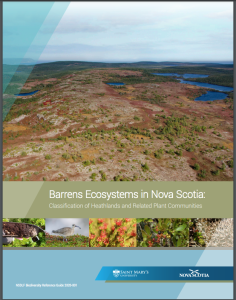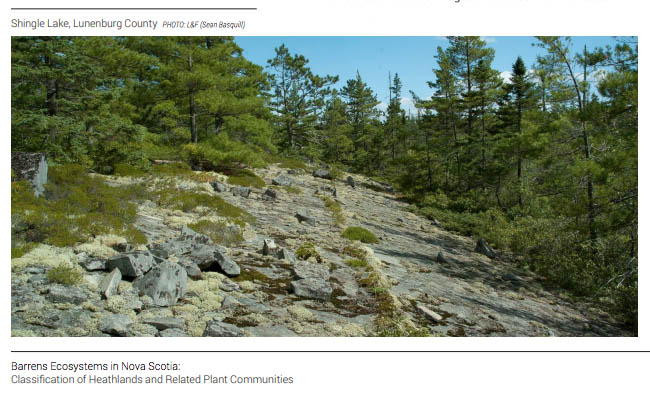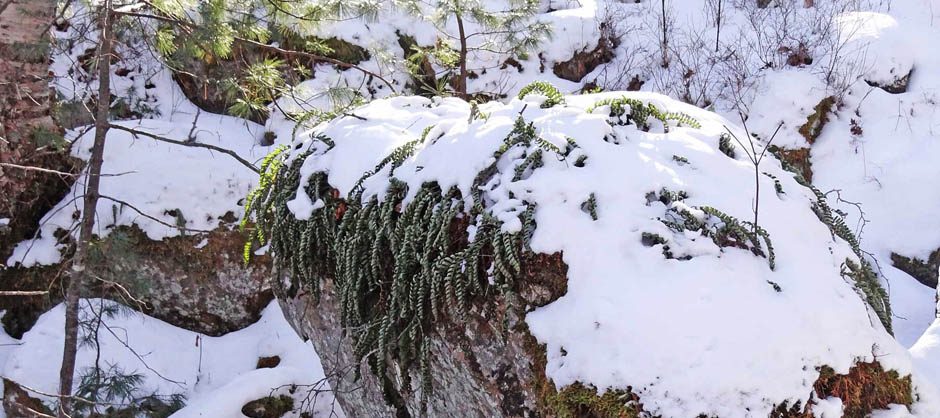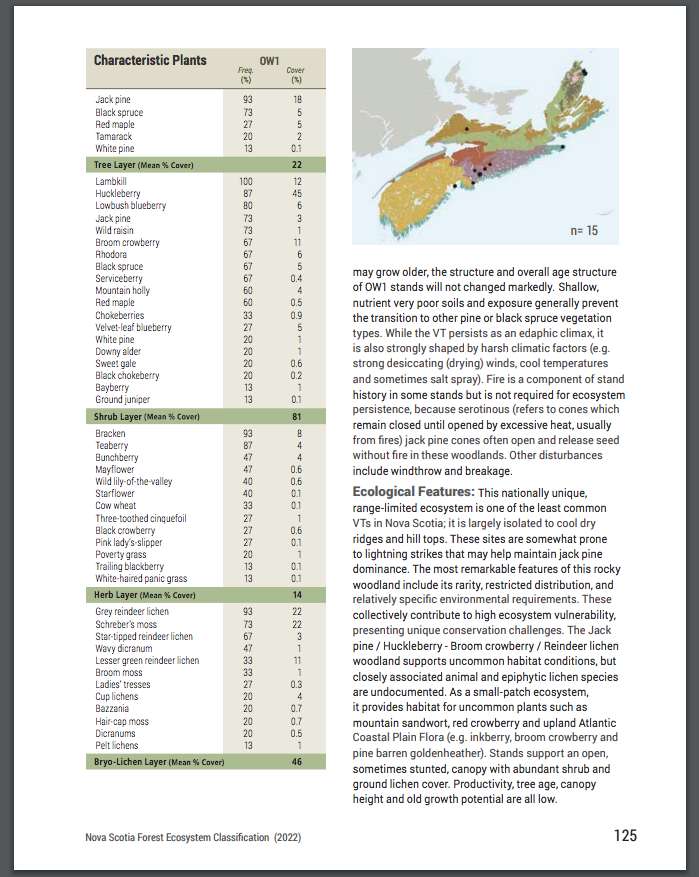DRAFTING
A comprehensive classification of Barrens Ecosystems in Nova Scotia was published in 2021:
 Porter, C.J.M., Basquill, S.P. and Lundholm, J.T. 2020. Barrens Ecosystems in Nova Scotia: Classification of Heathlands and Related Plant Communities. Joint publication of Nova Scotia government and Saint Mary’s University. Nova Scotia Department of Lands and Forestry, Biodiversity Reference Guide 2020-001, 72 pages Porter, C.J.M., Basquill, S.P. and Lundholm, J.T. 2020. Barrens Ecosystems in Nova Scotia: Classification of Heathlands and Related Plant Communities. Joint publication of Nova Scotia government and Saint Mary’s University. Nova Scotia Department of Lands and Forestry, Biodiversity Reference Guide 2020-001, 72 pagesAvailable as a PDF at https://novascotia.ca/natr/wildlife/pdf/Barrens-Classification.pdf |
Under the Dwarf Shrubland group (DS), Broom Crowberry is cited as an indicator species for 5 of the 14 Associations:
DS7. Broom Crowberry Coastal Barren
DS10. Broom Crowberry Rock Barren
DS11. Broom Crowberry Inland Barren
DS12. Broom Crowberry Sand Barren
DS14. Broom Crowberry Coastal Dune
Of those, DS7, DS10 and DS11 have significant overlap with the JP/BC Barrens in regard to substrate type and vegetation. Extracts for those 3 Associations are given below.
DS7. Broom Crowberry Coastal Barren
Concept This association occurs on moderately sheltered to exposed coastal sites and is dominated by Broom Crowberry (Corema conradii) and typically includes abundant Common Juniper (Juniperus communis) and patches of Cladonia boryi. It is the only Broom Crowberry barren community in Nova Scotia occurring on coastal glacial till and bedrock outcrops.

Source: Porter et al., 2020 Barrens Ecosystems in Nova Scotia: Classification of Heathlands and Related Plant Communities NS Gov doc.
Environment Sites occur along the coast and on moderately sheltered to exposed topography. This association is most common on sites with prominent ridges of exposed bedrock. It is situated outside the influence of salt spray, typically at distances greater than 100 m from the ocean. Soils consist of variably thin (usually 7–40 cm), poorly developed humus over bedrock. Moisture regime varies broadly. It occurs most often at xeric sites but can also occur at moist sites.
Vegetation This association is characterized by the co-dominance of Broom Crowberry (Corema conradii) and Common Juniper (Juniperus communis) in the shrub layer. Other shrubs present with lesser abundance may include: Lowbush Blueberry (Vaccinium angustifolium), Eastern Teaberry (Gaultheria procumbens), Three-toothed Cinquefoil (Sibbaldia tridentata), Foxberry (Vaccinium vitis-idaea), Black Crowberry (Empetrum nigrum), and Common Bearberry (Arctostaphylos uva-ursi). The herbs Northern Starflower (Lysimachia borealis) and Wild Lily-of-the-Valley (Maianthemum canadense) are moderately constant. Lichens frequently include the species Grey Reindeer Lichen (Cladonia rangiferina), Thorn Cladonia (Cladonia uncialis), Reindeer Lichen (Cladonia arbuscula ssp. squarrosa), and the indicator species Fishnet Lichen (Cladonia boryi). Frequently occurring bryophytes species include the mosses Bristly Haircap Moss (Polytrichum piliferum) and Spurred Broom Moss (Dicranum spurium). Vegetation dynamics may be indicated by the presence of structural complexity typical of the association. Taller shrubs such as Dwarf Huckleberry (Gaylusaccia bigelovania), herbaceous species such as Bracken Fern (Pteridium aquilinum), and trees including Balsam Fir (Abies balsamea), Red Maple (Acer rubrum), and or Jack Pine (Pinus banksiana) sometimes occur. While Broom Crowberry (Corema conradii) is diagnostic for this association, this species occurs far less frequently in coastal areas than the other common crowberry species in Nova Scotia, the Black Crowberry (Empetrum nigrum). This association is much drier than the Black Crowberry mesic coastal barren (DS6), supporting lower levels of coastal associates like Foxberry (Vaccinium vitis-idaea), Red Fescue (Festuca rubra), and Newfoundland Reindeer Lichen (Cladonia terrae-novae).
DS10. Broom Crowberry Rock Barren
Concept This association is characterized by dominance of Broom Crowberry (Corema conradii) on low elevation bedrock exposures throughout the interior of Nova Scotia. Vegetation cover ranges along a gradient in soil depth, from extensive spreading mats to sparse patches rooted in rock crevices. It is the only inland Broom Crowberry barren found on exposed bedrock outcrops. A similar association occurs on coastal bedrock exposures where ambient humidity is higher from onshore oceanic influences (unit DS8).

Source: Porter et al., 2020 Barrens Ecosystems in Nova Scotia: Classification of Heathlands and Related Plant Communities NS Gov doc.
Environment Sites are of moderate to negligible exposure and occur throughout the province’s low elevation interior. The association occurs at a variety of slope positions but most frequently occupies steep upper slopes, the crests of hills and prominent bedrock ridges. It is common both as a component of large open, near-treeless barrens and also on bedrock ridges embedded within forested landscapes, or on lakeshores. Shallow, nutrient poor soil limits the establishment of taller more extensive vegetation cover. Soils consist of a thin, poorly developed humus over bedrock. Sites are characterized by a very dry to dry moisture regime (very xeric xeric).
Vegetation Broom Crowberry (Corema conradii) is the dominant species, while Lowbush Blueberry (Vaccinium angustifolium) and Black Huckleberry (Gaylussacia baccata) are frequent co-occurring shrubs. Sheep Laurel (Kalmia angustifolia) and lesser amounts of Eastern Teaberry (Gaultheria procumbens) occasionally occur. Trees may be scattered sparsely. Several species of Reindeer Lichen (Cladonia spp.) are both frequent and abundant at most sites. Among the most common Reindeer Lichens are: Thorn Cladonia (Cladonia uncialis), Fishnet Lichen (Cladonia boryi), Startipped Reindeer Lichen (Cladonia stellaris), Grey Reindeer Lichen (Cladonia rangiferina), and Reindeer Lichen (Cladonia arbuscula ssp. squarrosa). Cladonia strepsilis is more frequent in the association than any other inland dwarf shrubland represented in this guide. Lichen and bryophyte species characteristic of acidic rock substrate include: Umbilicaria muhlenbergii, Polytrichum piliferum, Andreaea rupestris, and Bucklandiella venusta, among other species.
DS11. Broom Crowberry Inland Barren
Concept The Corema conradii Arctostaphylos uva-ursi / Cladonia spp. Dwarf Shrubland Association occurs in the interior of Nova Scotia on shallow and excessively stony morainal (glacial) deposits. It is the only inland Broom Crowberry barren found on morainal deposits. The association is conceptually similar to unit DS9‹Bearberry Lowbush Blueberry Inland Barren, an earlier successional community, and to DS12‹Broom Crowberry Sand Barren, which is strongly limited to deep and well-sorted glaciofluvial sand deposits, relatively free of stones and boulders.

Source: Porter et al., 2020 Barrens Ecosystems in Nova Scotia: Classification of Heathlands and Related Plant Communities NS Gov doc.
Environment Sites have moderate to negligible exposure and occur throughout the province’s southwestern interior. They are common across large areas of glacial veneer typical of this region. The association occurs at a variety of topographic positions including upper slopes, hill crests, level flats, and lower slopes. Soils are dry, nutrient-poor, and often stony. Historic fire evidence was documented in some occurrences.
Vegetation Broom Crowberry (Corema conradii) is the dominant species. Lowbush Blueberry (Vaccinium angustifolium) and Black Huckleberry (Gaylussacia baccata) are frequent co-occurring shrubs, while Sheep Laurel (Kalmia angustifolia) and lesser amounts of EasternTeaberry (Gaultheria procumbens) occasionally occur. The herbaceous layer may be depauperate; few species occur with high constancy, other than Bracken Fern (Pteridium aquilinum), which is extensive in some stands. The occasional presence of tall shrubs and trees within this association may suggest a successional transition to taller shrub or treed vegetation. Tall shrubs and trees are often observed on sites that were burned, especially in Southwestern Nova Scotia. Eastern White Pine (Pinus strobus) is the most frequent tree species present and large trees can comprise up to 30% cover. Red Oak (Quercus rubra), Black Spruce (Picea mariana), and or Red Maple (Acer rubrum) are also occasional constituents. At some sites, Bracken Fern (Pteridium aquilinum) and Black Huckleberry (Gaylusaccia baccata) are abundant and can even be canopy forming. Lichen cover can be extensive but is generally limited to common Reindeer Lichen species (Cladonia). Star-tipped Reindeer Lichen (Cladonia stellaris), Grey Reindeer Lichen (Cladonia rangiferina), and Reindeer Lichen (Cladonia arbuscula ssp. squarrosa) are typical.
Comment, Jack Pine is cited as a possible or “sometime” component for only one of these associations, (DS7. Broom Crowberry Coastal Barren), however, the description for DS10 (Broom Crowberry Rock Barren) applies well to many sites of the mostly treeless fringe in JP/BC Barrens of the Backlands.
A “Barren” is defined in Porter et al., 2020 thus:
Barren — an open, generally treeless type of ecosystem dominated by low and or creeping shrubs, forbs or graminoids and maintained by environmental extremes such as wind, salt spray and/or shallow soils (Oberndorfer and Lundholm, 2009)*
*Oberndorfer, E. & Lundholm, J. (2009). Species richness, abundance, rarity and environmental gradients in coastal barren vegetation. Biodiversity Conservation 18: 1523–1553.
The JP/BC Barrens as we (Hill and Patriquin, 2014) have described them* correspond more closely to NS Forest Vegetation Type OW1 as described by Neily et al., 2023 (and see JP/BC Barrens – relationship to NSFVT OW1 on this website).
OWI is an “Open Woodlands” Vegetation Type which is defined as “Stands in an open woodland condition where natural disturbances or site have limited the establishment of trees to less than 30% crown closure or stands with excessively stony, steep slopes of colluvium interspersed with pockets of talus”.
Below is a screen capture of the two pages from Neily et al., 2023 describing OW1:
Jack Pine/Broom Crowberry Barrens (Hill and Patriquin 2014)
In this VT, Jack Pine occurs (i) as single or a few gnarled trees growing in cracks on rock barrens, (ii) in smallish (10-50 m across) treed patches with Jack Pine alone or dominated by Jack Pine and (iii) in more contiguous, larger patches interrupted by rock barrens or wetlands. Tree canopy cover ranges from less than 10% percent to about 60%. Big-toothed Aspen is the most common other tree in most mixed stands, followed by Red Maple, Wire & Paper Birch, Red & Black spruce. (Additionally, Jack Pines occur singly and in clusters in the Red Pine/Jack Pine/Broom Crowberry VT, and isolated Jack Pines occur in the Birch/Maple/Aspen VT, usually adjacent to their occurrence on Jack Pine/Broom Crowberry Barrens.) Broom Crowberry and Huckleberry are the most common associated shrubs, the Broom Crowberry occurring in edge areas on shallower soils, often with Reindeer Lichen, while Huckleberry occurs on deeper soils, growing tallest (to circa 1.5 m) where there is more exposure to the sun. Sheep Laurel may also occur, and in wet pockets, Huckleberry is replaced by one or more of Leatherleaf, Rhodora, Inkberry.





